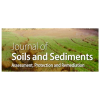
Purpose
Phosphorus (P) sorption processes in soils can influence P plant-availability and influence ‘build-up’ and ‘draw-down’ P cycles. Current fertiliser recommendations do not take these processes into account. This study aimed to integrate soil P sorption behaviour and P agronomic-indices to strengthen P management recommendations.
Methods
Mineral soil covering 35,716-km2 of Ireland was characterised by P status (Morgan’s P and Mehlich-3 P), and Langmuir sorption parameters of P sorption maximum capacity (Smax, mg·kg−1) and binding energy (k, L·mg−1).
Results
Segmented regression between Smax and M3-Al (R2 = 0.49) identified a significant change-point at Smax = 450.03 mg·kg−1, at which soils can be placed into ‘low’ (SLM3-Al) and ‘high’ (SHM3-Al) P sorbing classes. Sorption parameters in SLM3-Al did not change with soil P status; however, in high P sorbing soils, sorption parameters significantly correlated with P status. High sorbing soils that are P-deficient (Index 1 and 2) will ‘fix’ P and take longer to build-up plant available P to a value for agronomic production (Index 3). Low P sorbing soils at high P status (Index 4) will decline to Index 3 at faster rates than high P sorbing soils. These soils (SLM3-Al) are at higher risk of soluble P losses to water because of lower binding energies.
Conclusions
Efficient P fertiliser use can be more effective if soils are delineated into ‘low’ and ‘high’ sorbing soils coupled with soil P status. By integrating P sorption capacities with agronomic soil P indices, fertiliser advice and water quality measures can be targeted and more effective.
